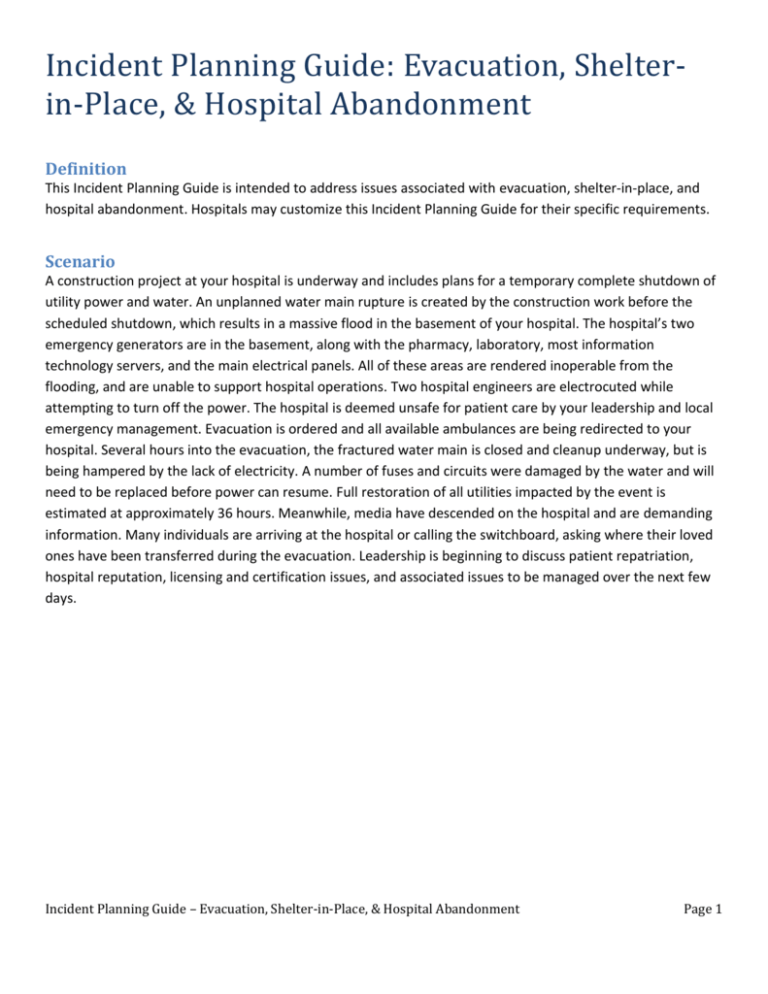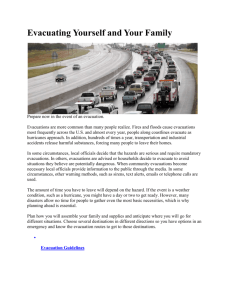Evacuation, Shelter-in-Place, and Hospital Abandonment IPG
advertisement

Incident Planning Guide: Evacuation, Shelterin-Place, & Hospital Abandonment Definition This Incident Planning Guide is intended to address issues associated with evacuation, shelter-in-place, and hospital abandonment. Hospitals may customize this Incident Planning Guide for their specific requirements. Scenario A construction project at your hospital is underway and includes plans for a temporary complete shutdown of utility power and water. An unplanned water main rupture is created by the construction work before the scheduled shutdown, which results in a massive flood in the basement of your hospital. The hospital’s two emergency generators are in the basement, along with the pharmacy, laboratory, most information technology servers, and the main electrical panels. All of these areas are rendered inoperable from the flooding, and are unable to support hospital operations. Two hospital engineers are electrocuted while attempting to turn off the power. The hospital is deemed unsafe for patient care by your leadership and local emergency management. Evacuation is ordered and all available ambulances are being redirected to your hospital. Several hours into the evacuation, the fractured water main is closed and cleanup underway, but is being hampered by the lack of electricity. A number of fuses and circuits were damaged by the water and will need to be replaced before power can resume. Full restoration of all utilities impacted by the event is estimated at approximately 36 hours. Meanwhile, media have descended on the hospital and are demanding information. Many individuals are arriving at the hospital or calling the switchboard, asking where their loved ones have been transferred during the evacuation. Leadership is beginning to discuss patient repatriation, hospital reputation, licensing and certification issues, and associated issues to be managed over the next few days. Incident Planning Guide – Evacuation, Shelter-in-Place, & Hospital Abandonment Page 1 Does your Emergency Management Program address the following issues? Mitigation 1. Does your hospital address the threat and impact of evacuation, shelter-in-place, and hospital abandonment in the annual Hazard Vulnerability Analysis, including the identification of mitigation strategies and tactics? 2. Does your hospital participate in pre-incident local response planning with public safety officials (e.g., emergency medical services, fire, and law enforcement), local emergency management officials, other area hospitals, regional healthcare coalition coordinators , and other appropriate public and private organizations, including meetings and conference calls to plan and share status? 3. Does your hospital have multiple methods and equipment for evacuating patients (e.g., chairs, stretchers, backboards, evacuation assist devices, blanket drag, single person carry, multiple person carry)? 4. Does your hospital have evacuation equipment for bariatric and special needs patients? 5. Does your hospital have an evacuation policy for non-patient care areas that includes securing data and the movement of equipment? 6. Does your hospital provide regular training on evacuation and shelter-in-place? 7. Does your hospital define and provide special equipment that may be needed during evacuation and shelter-in-place (e.g., flashlights, headlamps, light sticks, sealing tape, etc.)? Preparedness 1. Does your hospital have an Evacuation, Shelter-in-Place, and Hospital Abandonment Plan? 2. Does your hospital exercise the Evacuation, Shelter-in-Place, and Hospital Abandonment Plan yearly and revise it as needed? 3. Does your plan include preparedness strategies to reduce the impact of evacuation and shelter-in-place? 4. Does your hospital participate in community evacuation and shelter-in-place exercises? 5. Does your hospital identify who has the authority to order hospital evacuation and shelter-in-place? Does your hospital have a protocol and criteria that defines: 6. Shelter-in-place versus evacuation? Immediate versus delayed evacuation? Vertical versus lateral evacuation? Partial versus complete evacuation? Incident Planning Guide – Evacuation, Shelter-in-Place, & Hospital Abandonment Page 2 Does your hospital have a Communications Plan that includes: 7. Pre incident standardized messages for communicating the risks associated with this incident and recommendations to the public and media? Participation in the Joint Information Center in cooperation with local, regional, and state emergency management partners? Use of social media for communication, including: o Who can use social media? o Who approves the use of social media? o When is use of social media not appropriate? Procedure for notification of internal and external authorities (local, county, region, state)? A plan to distribute radios, auxiliary phones, and flashlights to appropriate people and areas? A plan for rapid communication of weather status (watch, warning)? A plan for rapid communication of situation status to local emergency management and area hospitals? A process to identify patients and to notify family members? Does your hospital have staffing plans that include: 8. Contingency staff utilization and support plans? An established list of backup or relief staff that need to be in the hospital before or after the incident to continue patient care, if applicable? A list of nonessential staff that may be used in alternate roles? A plan to modify staffing and hours of work? Immediate and Intermediate Response 1. Does your hospital have criteria and a rapid decision making process to determine the need to activate the Evacuation, Shelter-in-Place, and Hospital Abandonment Plan? Does your hospital’s Evacuation, Shelter-in-Place, and Hospital Abandonment Plan include: 2. Procedures for immediate, controlled, and planned evacuation or shelter-in-place of the hospital? Authority to activate the plan and recover from the event? Established priorities for patients and the hospital? Procedures and tracking systems for all patients (ambulatory and non-ambulatory), staff, visitors, and equipment? Designated evacuation locations, assembly areas, and routing options, including: o Within the hospital (atrium, auditorium, gym, etc.)? o External to the hospital (adjacent building, nursing home, other hospitals, schools, etc.)? Processes for initiating assembly area and holding area operations, including the provision of adequate staff and equipment? Process to facilitate the transfer of individual patient information, medications, and valuables with the patient? Defined personnel roles in the evacuation? Processes to reassign staff to alternate sites and staging areas, and other hospitals? Coordination with ambulances, aeromedical services, and other transportation providers, including: o Additional out of area medical transportation? o Nonmedical transportation providers (school buses, other types of buses, etc.)? Incident Planning Guide – Evacuation, Shelter-in-Place, & Hospital Abandonment Page 3 Business Continuity Plans that include use of computerized patient records and billing records from another, adequately secured location? Does your Evacuation, Shelter-in-Place, and Hospital Abandonment Plan address communications including: 3. 4. Rapid notification of local emergency management, other hospitals, and regional resources of the need for immediate evacuation or shelter-in-place of the hospital and to ascertain their situation status? Rapid family notification of evacuation and where patients are being relocated? Regularly providing information and updates to patients, staff, families, and the media? Does your hospital have a plan to supplement staffing through call backs or requesting other resources from local emergency management, the local Emergency Operations Center, emergency medical services, fire, law enforcement, and regional medical resources? Does your hospital have a process for safe shutdown of the hospital, including: 5. Computers, patient monitors, and other electrical equipment shutdown? Heating, ventilation, and air conditioning? Power, water, gas, and medical gases? Methods to protect paper records not being evacuated? Securing animal research areas? Maintaining hospital security in all areas during and after closure? 6. Does your hospital have policy and procedures that address the securing or movement of hazardous materials if the hospital is evacuated? 7. Does your hospital have a plan to provide rest and sleep areas, nutrition, and hydration to staff? Extended Response and System Recovery Does your hospital have a process to maintain: 1. Patient tracking? Response integration with external agencies and hospitals? Supplies, equipment, and staffing to support an alternate location? Does your hospital have a process to: 2. Perform interior and exterior damage assessments? Salvage equipment remaining onsite? Secure kitchen and laundry areas? Secure diagnostic radiology areas, medications, and isotopes? Maintain heating, ventilation, and air conditioning control, as needed? Maintain traffic control on campus, as needed? Ensure adequate space for rest areas and hygiene for staff and family members who may be required to remain in the hospital? Monitor severity of damage and progress of repairs? Report damage to the Hospital Command Center and initiate appropriate repairs during and after the incident? Monitor contractor services (work quality, costs, etc.)? Incident Planning Guide – Evacuation, Shelter-in-Place, & Hospital Abandonment Page 4 Update inventories of equipment, supplies, and medications? Determine hospital cleaning needs, including the use of contract service assistance? Ensure equipment, medications, and supplies are reordered to replace stock supplies? Ensure all necessary equipment is usable and safety checked, and equipment and supplies are reordered, repaired, and replaced as warranted? Return borrowed equipment after proper cleaning and replenishment of supplies? Prioritize service restoration activities? Restore normal nonessential service operations? Does your hospital have criteria for reopening the hospital that consider: 3. Differences between partial and complete evacuation? Certification by local authorities (public health, fire, licensing and accreditation agencies, etc.)? Regulatory issues? Psychological considerations of reoccupation? Corporate influence? Funding? Does your hospital have a process for notifying: 4. Local and state Department of Health, licensing, and regulatory agencies? Staff? Other hospitals? Local emergency management, Emergency Operations Center, and emergency medical services? Media? Patient families? Does your hospital have a mechanism for: 5. Support area restoration? Clinical area restoration? Outpatient service restoration? Blood bank service restoration? Animal lab restoration, when indicated? Heating, ventilation, air conditioning, and medical gas restoration? Staffing? Pharmacy restocking? Food service restoration? Linen service restoration? Return of equipment and supplies from holding sites? Does your hospital have procedures for repatriation of patients and staff, including: 6. Managing patients dissenting from repatriation? Patient transportation coordination with sending hospitals? Medical records management? Attending physician assignments? Room assignments? Patient registration? Incident Planning Guide – Evacuation, Shelter-in-Place, & Hospital Abandonment Page 5 7. Does your hospital have a continuing process to capture all costs and expenditures related to operations? 8. Does your hospital have procedures to debrief patients, staff, and community partners? 9. Does your hospital have Hospital Incident Management Team position depth to support extended operations? 10. Does your hospital have a Business Continuity Plan for long term events? 11. Does your hospital have procedures to collect and collate incident documentation and formulate an After Action Report and Corrective Action and Improvement Plan? Incident Planning Guide – Evacuation, Shelter-in-Place, & Hospital Abandonment Page 6






